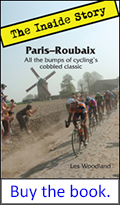

Course Strategy
by Hunter Allen
Back to Training and Fitness index page

Les Woodland's book Paris-Roubaix: The Inside Story - all the bumps of cycling's cobbled classic is available as an audiobook here. For the print and Kindle eBook versions, just click on the Amazon link on the right.
Hunter Allen writes:
Each type of race and each type of course dictates a little bit different strategy. Here are some tips to help you pick your plan of attack!
Road Race
Hilly—These are courses that seem to have undulating hills that go on forever. They are constantly up and down, and a good example of this is the Jefferson Cup races. Races like these usually come down to two different finishes. #1, a sprint finish, and #2, a break away, either a small group or fairly large one.
Strategy—Position someone for the sprint, or make sure to have someone in the break. Easier said than done right, right? The main thing to consider is the “other riders and teams” and your team riders have their strengths and weaknesses. Always cover the stronger riders’ attacks, so that you will always have someone in the break. Also, make sure to pay attention to the combination of teams in the attack and see if they contain the strongest teams. If no one gets away and the race comes down to sprint, your strategy must be to get one of two of the strongest sprinters to the front and lead them out. Do your best to contain late race attacks and then play your cards correctly, so your best guy will have a chance at the WIN!
Flat—These are very similar to hilly courses in strategy, but almost always come down to a sprint finish. Only if the course has an exposed windy side, or several strong riders can get together, then there will be a breakaway.
Strategy—Also similar to the hilly strategy, however, make sure to save a bit more energy this time for the sprint finish as that has a highly probability of coming true. If it is windy, make sure to use it to your advantage. Always be in the front and on the shielded or “leeward” side. That way you will waste little to no energy and be stronger when the attack comes. In the final sprint, be mindful of the wind and how the course “comes into” the finishing straight. Make sure to station yourself on the “leeward” side again and sprint from a sheltered position if possible.
Climbing—Races like these are pretty easy to race in, because everyone waits for the climbs and then goes absolutely berserk up them and the race is determined.
Strategy—Train your climbing abilities! In the race, save energy until the climb and then go for it, like everyone else. Make sure to pace yourself through and NOT blow-up! Another strategy is: try to get away before the climb and then meet the climbers at the top so you’ll already be in the break after the climb. This is a great strategy for a non-climber or someone who doesn’t climb awesome.
Criterium
Flat 4 corner—Usually comes down to a field sprint, 9 times out of 10.
Strategy—Win some primes, to see how the final sprint will play out and then make sure to be at the front or very near it with 10 laps to go. Make sure that you know what place you need to be in around the final turn in order to win the race. If it is a wide road, then most of the time it is a crap shoot in terms of holding your position and staying in the front at the finish. You need to pay attention to the course and see where the holes are opening up throughout the race and move up through those. Force yourself to stay in the pack if you are a good sprinter, and save your energy for the finish. The start doesn’t matter quite so much.
Lots of turns—Breakaway or field sprint. Usually a break near the end. The start is usually VERY crucial! Be near the front at the start and stay up there for the race. You will save SOO much energy. Make sure to find the “lines” through the turns and use them. Try to get a small break going if you can, but don’t kill yourself to keep it going if it isn’t working.
Strategy—Focus on looking farther in front of you than normal and NOT on the rider’s back wheel directly in front of you! Make sure you know EXACTLY which position to be in before the last turn heading into the finish. Make sure to warm-up VERY well beforehand to make sure your body doesn’t have to go through that “shock” period that is normal at the beginning of the race.
Turns and a hill—A breakaway usually wins this one!
Strategy—Again your warm-up and start are super important. Make sure to be VERY ready for the race and also near the front of the race. The main thing is to be strong and fit for this type of race. The course dictates the tactics and the main thing is to be strong enough to be in the lead and go from there.
Time Trial
Uphill—Get in a very intense warm-up and go from the start to the finish as hard as you can, while making sure not to blow-up!
Flat—Another good warm-up and be mindful of the wind. Make sure if it is a headwind on the way out, go pretty hard, because you will have a tailwind to help you on the way back. If it is a tailwind on the way out, then be careful to save some energy for the ride back in! The main thing to focus on is your breathing rhythm and the feeling in your legs. Do not think about the bills you have to pay, the nice trees along the route, etc. CONCENTRATION is the KEY!
Breaking Away…
You are in the break—great! Now what? If you are a weaker rider or feeling weaker, then do 1 of 2 things. #1: Sit-on-Rest and maybe you’ll come around. #2: Pull, but not super hard, just keep the pace going. Many times when the break is getting established, you have no choice. Pull or get caught, however, once it is established it is easier to rest.
If you are the strongest rider, motor the break, but make sure to keep it consistent at the front and smooth. DO NOT go so hard that you do 80% of the work. If you are doing 80% of the work, then sit up and try for a different combination of riders. The original break probably would not have worked anyway and you would have ended up getting tired in the process. DO ride hard and make sure that you are confident of being able to jump away towards the end or win the sprint. Don’t get fooled by other riders, who may be bluffing about their weaknesses. Don’t be too eager to drive the break, but make sure to be vocal and encourage the break to work together and go fast.
Be careful and assess your breakaway companions' strengths and weaknesses. Make sure to eat and drink at the back of the break or shake out your legs at the back, so others won’t see you.
If your jump is slow and the finish is coming up, you might want to drop off the back a bit and then attack (slingshot) around the rest of the break. This is great to do because you pass the rest of the break at max speed and they can’t get your wheel and they must make a MAJOR effort to get you back.
Blocking
Blocking is part of bike racing and if done properly, it is a very effective tool to assist a teammate or friend who is in a breakaway. If done incorrectly, it leads to very negative racing.
Blocking should be done subtly and smoothly. DO NOT go to the front of the pack and slow down, other riders will recognize this and just go around. Go to the front and ride “tempo”—a fast pace, but slower than you know that the break is going. This allows the break to gain time but discourages other riders from attacking or coming around you.
Another good technique is to lead into the turns and slow down a lot for each turn and then sprint hard out of each one. That creates an accordion effect and makes it very hard for a chase to develop. Your speed will be fast on the straights, but slow through the turns, and allow the break to get away.
Attacking
Do attack at every “lull” that you can, especially in criteriums. Don’t attack when the pace is 35mph+! Attack from farther back in the pack and get the “jump” on the other riders. Attack going into turns to get a gap. Attack on hills, or at the top of the hill.
Make your attacks count! Don’t just attack every other chance you get, but do attack with purpose and commitment. Good places to attack in Road Races are on the upside of a long downhill (use your momentum). Also, attack in the crosswinds and ride on the side of the road that will not allow anyone to draft until you get someone to help you.
Halfhearted attacks are nothing but a waste of energy. You have to attack to win!
Back to Training and Fitness index page








